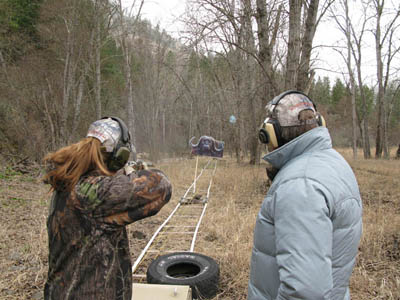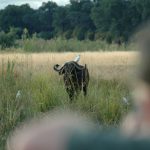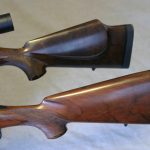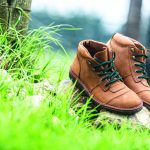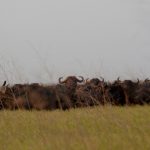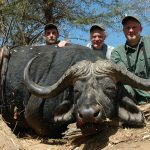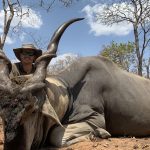Trying out a variety of dangerous game rifles and learning how to stop a charge at a big-bore shooting clinic.
All I could see of the large Cape buffalo was its face, horns, and chest as it started toward me from the edge of the trees, coming at a steady clip. I readied the double rifle and settled the open sights between its nostrils, just as the professional hunter had instructed.
Boom! Though hit squarely, the buffalo kept coming. I came out of the recoil, settled the sights again, slid my finger to the rear trigger, and held my fire. “Wait until he’s so close you can’t miss,” the professional hunter had said. Could I really stand my ground and let him come?
Boom! The buffalo head—a realistic cardboard facsimile attached to a rail and rolling toward me via a remote controller—creaked to a halt right in front of me with two .40-caliber holes in its nose.
“It’s a little more difficult when it’s a real buffalo coming at you, but you get the idea,” said PH Joe O’Bannon.
I broke open the double rifle and two enormous .450/.400 cases arced over my right shoulder. Chris Sells, marketing director of Heym USA, scooped up the valuable brass. “What did you think?” he asked. “Want to try it with the .470?”
I grinned at him as I handed the rifle back. “I love this rifle—it’s really comfortable to shoot,” I said. “But I don’t really need to shoot the .470 again—thanks for the offer, though.”
Earlier that day I’d taken some shots at a moving rhino target with a similar double rifle in .470 Nitro Express, and found the recoil unpleasant. But that’s why I was here, at a Stopping Rifle Clinic at Idaho’s Flying B Ranch: to gain experience in shooting a number of different big-bore rifle styles and calibers, and to assess my own preferences and tolerance for recoil under the watchful eye of experts. So far I’d become a fan of the Heym double in .450/.400 3-inch, as well as a Granite Mountain Arms .375 H&H bolt rifle and Doug Turnbull’s beautiful .475 Turnbull lever gun. I was less enamored of the Heym .470 and another Granite Mountain Arms bolt gun in .416 Rigby.
“Recoil is a subjective thing, but experience and technique make a difference,” Sells had explained to our class earlier in the day. We were reminded, for example, not to jam our cheekbones down on the stock of a big bore—the proper hold is with the stock pulled snugly into the pocket of the shoulder, but resting slightly low on the cheek. That helped, in most cases, but an individual’s tolerance is hard to predict. Some shooters at the clinic loved the .470, for example; others disliked it, and their reactions did not necessarily relate to the size of their physique, which surprised me. It seemed to me that any of us could have learned to be good shots with even the heaviest rifles, however, were we willing to put in the practice time.
The Stopping Rifle Clinic was geared toward hunters who own or are about to purchase a large-bore rifle for the pursuit of dangerous game. Participants could bring their own rifles or shoot the ones available at the clinic. The two-day (Saturday and Sunday) clinic packed in an incredible amount of information as well as plenty of shooting practice.
The classroom sessions featured much discussion of the advantages and disadvantages of double rifles, bolt actions, and lever guns for use on dangerous game, and experts on all three types were on hand to discuss what to look for and how to choose and test a dangerous-game rifle. We also learned what these experts prefer in terms of sighting systems on big-bore rifles; depending on the specific application, these ranged from high-quality, rail-mounted scopes to red-dot sights or traditional open sights.
Most interesting to me, however, were the detailed discussions regarding where to shoot elephant, buffalo, and big bears. An actual elephant skull was used to illustrate the proper shot placement for the brain shot on a pachyderm, and PH Joe O’Bannon even imparted a few pointers on how best to get away from a charging elephant (advice I hope I’ll never need to put into practice). With an incoming buffalo, we learned that if it is racing toward you with its head up, shoot for the nose. But if you wait until the buffalo is close, it will likely drop its head at the last minute. At that point—if your nerves hold–you can shoot right down into the brain.
Longtime brown bear guide Chris Goll discussed Alaska bear hunts and made some suggestions about the best rifle and caliber choices for this hunt, where the unpredictable weather can make otherwise dependable rifles behave badly. Goll also related several exciting stories about these huge bears and how to stop them. “A charging Kodiak can cover twenty-five feet in one bound,” he told his riveted audience.
For a hunter who is planning to invest money in a dangerous game hunt and/or a big-bore rifle, knowledge is power. Shooting a variety of rifles in realistic training scenarios can help prepare you for one of hunting’s most intense and satisfying experiences.
For information on the Flying B Ranch, go to www.flyingbranch.com.

